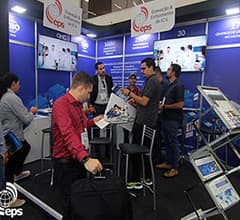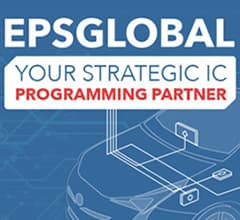Home > News & Blog > Interview with Electronics Bazaar
The benefits of outsourced chip programming services
The performance and accuracy of an IC depends primarily on how it is programmed, but finding the right talent in this field and arranging for the infrastructure may be expensive and time consuming for companies. The solution is to outsource IC programming services. Sravanthi Dagala, Sales Manager for EPS Global in India, talks to Baishakhi Dutta of Electronics Bazaar about the benefits of outsourced chip programming services, and how EPS Global is expanding its business in the domain.
EB (ELECTRONICS BAZAAR): HOW MUCH MORE PROFITABLE IS OUTSOURCING IC PROGRAMMING COMPARED TO SETTING UP AN INTERNAL TEAM?
SD (Sravanthi Dagala): Comparing costs alone doesn’t give you the true picture about the benefits of outsourcing versus inhouse manual programming. When you outsource your semiconductor programming to EPS Global, you benefit not only from reduced costs, but also get increased productivity and an integrated supply chain.
Our fully automated equipment and our adherence to standardised quality procedures (ISO 9001, TS16949 and VDA 6.3) ensure the highest levels of quality control with minimum handling. This results in a better yield and cost savings, as it minimises rejection rates, physical damage, non-programmed ICs and failures. This also expedites the process as there’s faster throughput with automated machines.
EB: WHAT ARE THE MOST ESSENTIAL PRE-REQUISITES THAT IC PROGRAMMING SERVICES PROVIDERS NEED IN ORDER TO DELIVER GOOD QUALITY TO THEIR CUSTOMERS?
SD: For IC programming services, skilled technicians and robust automated programming machines that can identity faults before and after programming, are very important.
EB: TELL US ABOUT YOUR IC PROGRAMMING SERVICE—YOUR USPS OVER THE COMPETITION, THE BENEFITS TO CUSTOMERS AND THE PROFITS YOU HELP CUSTOMERS EARN?
SD: EPS Global has a unique global footprint. We are strategically located in all major automotive electronics clusters worldwide, with state-of-the-art programming facilities in India, Hungary, Romania, the Czech Republic, Ireland, Brazil, Mexico, USA, China, Malaysia and Thailand.
EPS’s programming machines with automated handlers are built at our own R&D centre in the Czech Republic and cover the complete cycle of incoming visual inspection, automated IC loading onto the socket adapter, checksum checking, 3D visual inspection and co-planarity checking after programming. We can then package to any specification – tape to tape, tray to tape, tray to tray or tape to tray. Something we call #anyshapetoanytape. We also offer custom pocket tape manufacture; so we can handle devices of any shape or size. We don’t have any competitors that combine our level of quality, service or logistics in India.
There are some semiconductor distributors who support the pre-programmed ICs from their centres outside India, but they do so for higher volumes, at a higher price when compared to EPS’s programming services and with a NCNR (non-cancellable, nonreturnable) clause.
We can also offer programming services for lower volumes when required, and we can reprogram the ICs if there is any change in the code. Besides, our service is locally available.
EB: WHAT INDUSTRIES/VERTICALS DO YOU TYPICALLY CATER TO?
SD: EPS Global is a favoured service provider to OEMs and CEMs (contract electronics manufacturers) that run SMT lines across the globe. Our team of professionals has extensive experience working in many high velocity verticals ranging from automotive and consumer electronics, to the industrial, commercial, aerospace and defence domains.
EB: WHAT KIND OF TECHNOLOGIES DO YOU USE TO DELIVER YOUR SERVICES? DO AI AND IOT PLAY ANY ROLE?
SD: We use the following:
- 1. Innovative programmers for dual pick-and-place heads, 3D visual inspection, co-planarity checks and increased throughput.
- 2. In-tape programmers, assembled with ICT contact probes, for dot marking and visual inspection.
- 3. Machine monitoring software for real-time data, complete transparency, pass and fail graphs, running and pause indicators.
- 4. OCV vision system that improves quality yield, and checks orientation and marking.
Yes, AI and IoT play a role as we use automated handlers with our own machine monitoring software, which has built-in intelligence. Customers can send their code via our secure FTP site. Our code management database records all the necessary details and securely stores them for later retrieval, which is then incorporated in the customers’ ICs. We have the ability to offer secure programming solutions for critical IoT applications.
EB: HOW DO YOU ENSURE A QUICK TIME-TO-MARKET AND QUALITY CONTROL FOR YOUR CUSTOMERS?
SD: To ensure quality control, we use what I’d mentioned earlier— innovative programmers for dual pick and place heads, 3D visual inspection, co-planarity checks and increased throughput; as well as an OCV vision system that improves quality yield.
EB: DO YOU HAVE ANY CUSTOMERS IN INDIA?
SD: We do have a success story in India with a global automotive CEM. The firm had a very high scrap rate due to manual programming. There were cases of wrong programming or non-programmed ICs and even ICs with bent leads mounted on PCBs. During testing, the company had to scrap the entire board due to these issues. Since these boards were for automotive applications, the company couldn’t rework on the same PCB; hence its losses were high.
We had worked with this firm in other regions of the world so it had already audited our programming centres to its strict German automotive standards (VDA6.3). We also have some existing business with the firm in other regions. Our programmed devices were tested in the company’s factory and then sent to its OEMs for approval. Once we received approval, we signed programming contracts with the firm.
Getting new business in the automotive sector is a long and complicated process due to the high qualification and audit levels. To have been approved by this Tier 1 automotive electronics supplier is a massive achievement for us, and echoes the successes we’ve had in acquiring large automotive programming contracts elsewhere.
EB: HOW MUCH BUSINESS DOES THE INDIAN MARKET GENERATE FOR YOU? WHAT ARE YOUR PLANS TO INCREASE THAT HERE?
SD: There are huge business opportunities in India, because every electronics design has a programmable memory or a microcontroller. There is also a massive opportunity for growth in India. The drivers for growth are applications and electronics content in the automotive, consumer electronics, telecom and industrial fields. The CAGR for the total microcontroller market in India will be growing from 5 per cent in 2013-2015 to 8 per cent by 2020; so we have huge potential for growth in the country.
EB: DO YOU HAVE ANY OPERATIONAL OFFICES IN INDIA?
SD: We have recently set up a programming centre with an operations, sales and sales support team in Bengaluru and at another location onsite with one of our customers, apart from a sales office in New Delhi. We have 25 other global locations across four continents.
EB: WHAT GENERAL CHALLENGES DO YOU FACE AS AN IC PROGRAMMING SERVICES PROVIDER IN THE INDIAN ECOSYSTEM?
SD: In general, the sales cycle for acquiring new customers in the automotive IC programming space is long and drawn out due to the magnitude of the projects. These ICs are going into vehicles that will be on the road so there are higher audit and qualification levels, and rightly so. We understand the importance of committing to this market vertical for the long-term, well aware that there is a long time to revenue.
EB: WHAT IS YOUR ROAD MAP FOR INDIA?
SD: EPS Global plans to set up two to three programming centres in the automotive and the manufacturing hubs like Chennai, Pune and Delhi, based on the traction from customers.








